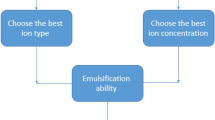Abstract
Water-in-oil emulsions containing silica nanoparticles (Aerosil R974) have the potential to stabilize microalgae for long-term storage. Studies were completed to determine if smectite clays could be used as an alternative to Aerosil R974. Emulsions were prepared with Aerosil R974, and hectorite and bentonite clays in the continuous phase and Chlorella sorokiniana was added to the aqueous phase to monitor the effects of solid particles on emulsion stability. Biological stability (cell viability) was determined using cell density measurements, and physical stability was measured from water droplet size distributions obtained by light scattering measurements and by examining phase separation over time. Measurements were also made to determine the effects of particles in the oil phase on emulsion viscosity. Particle concentrations greater than 0.25 wt% in the oil phase were required for maintaining physical stability. In emulsions containing 1 wt% solid particles and microalgae, biological stability of cells could be sustained for 340 days, regardless of particle type. At 1 wt% particles in the oil phase, apparent viscosity was 165 % greater for samples containing hectorite and bentonite clays compared to samples containing Aerosil R974. The higher viscosity would need to be considered in large-scale production of emulsions for commercial application.









Similar content being viewed by others
References
Amsellem Z, Sharon A, Gressel J, Quimby PCJ (1990) Complete abolition of high inoculum threshold of two mycoherbicides (Alternaria cassiae and A. crassa) when applied in invert emulsion. Phytopathology 80:925–929
Egley GHB, Douglas C (1995) Water-corn oil emulsion enhances conidia germination and mycoherbicidal activity of Colletotrichum truncatum. Weed Sci 43:312–317
Ho MA, Squire LM, Sabeh NC, Giles DK, VanderGheynst JS (2005) Design and evaluation of a grapevine pruner for biofungicide application. Bioresour Technol 96:963–968
Quimby PCJ, Boyette CD, Connick WJ (1989) An inverted emulsion replaces dew in biocontrol of sicklepod—a preliminary study. In: DA Hovde, GB Beestman (eds) Pesticide formulations and application systems, vol 8, pp 264–270
VanderGheynst JS, Scher H, Guo H-Y (2006) Design of formulations for improved biological control agent viability and sequestration during storage. Ind Biotechnol 2(3):213–219
VanderGheynst JS, Scher H (2009) US patent 7,485,45. storage stable compositions of biological materials. United States Patent,
Fernandez LC, Cheng YS, Scher H, VanderGheynst JS (2014) Managing the cultivation and processing of microalgae to prolong storage in water-in-oil emulsions. Appl Microbiol Biotechnol 98(12):5427–5433
VanderGheynst JS, Guo H-Y, Cheng Y-S, Scher H (2013) Microorganism viability influences internal phase droplet size changes during storage in water-in-oil emulsions. Bioprocess Biosyst Eng 36(10):1427–1434. doi:10.1007/s00449-013-0886-6
Binks BPC, Clint JH, Whitby CP (2005) Rheological behavior of water-in oil emulsions stabilized by hydrophobic bentonite particles. Langmuir 21:5307–5316
Bode R, Ferch H, Fratzscher H (1967) Basic characteristics and applications of Aerosil® Kautschuk+Gummi. Technical Bulletin Pigments, vol 20. Kunststoffe, p 578
VanderGheynst JS, Scher HB, Guo H-Y, Schultz DL (2007) Water-in-oil emulsions that improve the storage and delivery of the biolarvicide Lagenidium giganteum. Biocontrol 52:207–229
Bold H (1949) Some cytological aspects of Chlamydomonas-Chlamydogama. Am J Bot 36(10):795
Vonshak A (1986) Laboratory techniques for the cultivation of microalgae. CRC Press, Boca Raton
Mandalam RKP, Palsson B (1998) Elemental balancing of biomass and medium composition enhances growth capacity in high-density Chlorella vulgaris cultures. Biotechnol Bioeng 59:605–611
VanderGheynst JS, Dooley TM, Guo H, Scher H, Cheng Y (2010) Storage and release of solutes and microalgae from water-in-oil emulsions stabilized by silica nanoparticles. Process Biochem 45(1):1–6
Griskey RG, Green R (1971) Flow of dilatant (shear-thickening) fluids. AIChE J 17(3):725–728
Aveyard RB, Binks BP, Clint JH (2003) Emulsions stabilised solely by colloidal particles. Adv Colloid Interfac Sci 100:503–546
Boucher EA (1989) Separation of small-particle dispersions by the preferential accumulation in one of two liquid phases, or by static flotation at their interphase. J Chem Soc Faraday Trans 85:2963–2972
Binks BP (2002) Particles as surfactants—similarities and differences. Curr Opin Colloid Interface Sci 7:21–41
Starace AKG, Gomez JC (2013) Can particle-stabilized inorganic dispersions be high-temperature heat-transfer and thermal energy storage fluids? J Mater Sci 48:4023–4031
Lucassen-Reynders EH, Tempel MVD (1963) Stabilization of water-in-oil emulsions by solid particles. J Phys Chem 67:731–734
Abend SB, Bonnke N, Gutschner U, Lagaly G (1998) Stabilization of emulsions by heterocoagulation of clay minerals and layered double hydroxides. Colloid Polym Sci 276:730–737
Denkov NDI, Ivanov IB, Kralkchevsky PA, Wasan DT (1992) A possible mechanism of stabilization of emulsions by solid particles. J Colloid Interface Sci 150:589–593
Tadros TF, Vincent B (1983) Encyclopedia of emulsion technology. Basic theory, vol 1. Marcel Dekker, New York
Lagaly GR, Reese M, Abend S (1999) Smectites as colloidal stabilizers of emulsions. I. Preparation and properties of emulsions with smectites and nonionic surfactants. Appl Clay Sci 14:83–103
Yan NP, Pal R, Masliyah JH (1991) Viscosity correlations for emulsion solids mixtures as bimodal systems. Chem Eng Sci 46(7):1823–1828
Yan NP, Pal R, Masliyah JH (1991) Rheology of oil-in-water emulsions with added solids. Chem Eng Sci 46(4):985–994
Pal RM, Masliyah J (1990) Oil-recovery from oil in water emulsions using a flotation column. Can J Chem Eng 68(6):959–967
Midmore BR (1998) Synergy between silica and polyoxyethylene surfactants in the formation of O/W emulsions. Colloids Surf, A 145(1–3):133–143
Morrison I, Ross S (2002) Colloidal dispersions: suspensions, emulsions, and foams, vol 512. Wiley, London. doi:0-471-17625-7
Chader SM, Mahmah B, Chetehouna K, Amrouche F, Abdeladim K (2011) Biohydrogen production using green microalgae as an approach to operate a small proton exchange membrane fuel cell. Int J Hydrog Energy 36(6):4089–4093
Elementis-SPECIALTIES (2008) A comparison of smectite clays in underarm products. New Jersey
Acknowledgments
The authors wish to thank Dr. Christopher Simmons for providing illustrations of particles. This research was supported by National Institute of Food and Agriculture project CA-D-BAE-2228-RR, NSF grant MCB-1139644, and Chevron Technology Ventures LLC grant #RSO27.
Author information
Authors and Affiliations
Corresponding author
Rights and permissions
About this article
Cite this article
Fernández, L., Scher, H., Jeoh, T. et al. Room-temperature storage of microalgae in water-in-oil emulsions: influence of solid particle type and concentration in the oil phase. Bioprocess Biosyst Eng 38, 2451–2460 (2015). https://doi.org/10.1007/s00449-015-1482-8
Received:
Accepted:
Published:
Issue Date:
DOI: https://doi.org/10.1007/s00449-015-1482-8




